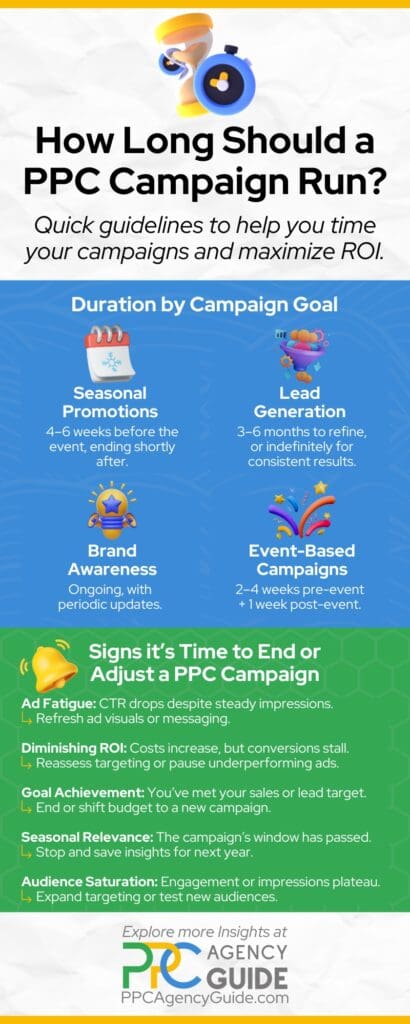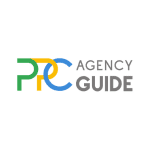
Wouldn’t it be nice if pay-per-click (PPC) campaigns came with a clear expiration date stamped on them? You’d know exactly when it’s “safe” to keep using them or when it’s time to toss them out. Unfortunately, the technology to make this happen doesn’t exist yet, but there are some basic guidelines you can apply as you’re setting campaigns up and tricks to tell you if yours are hitting their maximum shelf life. Below, we’ll explore PPC campaign duration best practices and tell you what to look for so you can maximize your return on investment (ROI).
Why PPC Ad Campaign Timing Matters
Before we break down PPC campaign length guidelines, let’s quickly review why timing matters.
PPC Campaigns Are Goal-Driven
When choosing between short vs. long PPC campaigns, it’s essential to consider your goals. Your ideal duration for PPC ads should align with these objectives.
- Short-Term Campaigns: Better for seasonal sales or time-sensitive promotions.
- Long-Term Campaigns: Better for building awareness or capturing ongoing demand.
For example, if you’re a florist, running ads two weeks before Valentine’s Day is perfect for last-minute shoppers. Running it six months in advance? That’s just wasting your budget.
Your Audience’s Behavior Changes Over Time
People’s interests, needs, and online behaviors fluctuate. A campaign that performs well today might lose its impact next month. This can happen due to:
- Ad Fatigue: Seeing the same ad repeatedly can lead to lower engagement.
- Seasonality: Consumer demand ebbs and flows throughout the year.
- Trends: Popular keywords or offers can quickly become outdated.
Maximizing Budget Efficiency
Running a campaign for too long, or at the wrong time, means you might be paying for clicks that don’t convert. A well-timed campaign ensures you’re targeting the right people when they’re ready to buy. At the same time, stretching your budget over too long a period can dilute the impact, especially if your audience is small.
Competitive Edge
PPC is all about being seen when it matters most. If your competitors are running ads during peak buying seasons and you’re not, you’re losing out. Similarly, running ads during quiet periods can help you stay top-of-mind while others pull back.
For instance, a small HVAC business might want to ramp up ads as temperatures drop, knowing customers are searching for heating services. In summer, they might scale back or shift focus to air conditioning services.
Data Collection and Campaign Optimization
Running a campaign for the right length of time also helps you gather meaningful data:
- Too Short: You might not have enough information to analyze performance.
- Too Long: You risk overspending or hitting diminishing returns.
What is a “PPC Campaign”
At first glance, a PPC campaign might seem straightforward: it’s a way to pay for ads and get clicks. However, depending on how your account is structured or how you define your goals, it can mean very different things. Let’s break it down.
The Basics: A Focused Effort to Achieve a Goal
A PPC campaign is essentially one organized effort to achieve a specific outcome. This could mean:
- Promoting a Seasonal Offer: For example, Valentine’s Day flower delivery ads.
- Highlighting a Service: Like a campaign for “free consultations” to generate leads.
- Driving General Brand Awareness: Ads that run year-round to keep your business visible.
No matter the focus, each campaign is built around specific keywords, audiences, and budgets designed to achieve that goal.
Common Ways to Define a Campaign
Here’s where things can vary. Depending on your goals or how your account is set up, a “PPC campaign” might be:
- Seasonal or Time-Sensitive Promotions: If you’re running ads for a Black Friday sale or back-to-school event, those ads might be grouped into one short-term campaign. For instance, a local bakery might run a “Holiday Treats” campaign for three weeks in December.
- Offer-Based Campaigns: When you’re promoting a specific offer, like a free trial or discounted service, everything tied to that offer (ads, targeting, and budget) could be part of one campaign. For example, a gym might run a “New Year, New You” campaign for sign-ups in January.
- Always-On Campaigns: Some businesses need ads running all the time to bring in steady traffic or maintain visibility. In these cases, a campaign might stay live indefinitely, with periodic adjustments. For instance, a locksmith might run a 24/7 emergency services campaign year-round to capture people searching in real time.
For Smaller Businesses: Think Simple
If you’re new to PPC, start by thinking of your campaigns as one focused effort with a clear objective. Keeping it simple makes it easier to:
- Measure: Know what’s working.
- Optimize Ad Spend: Put your budget to work effectively.
- Eliminate Waste: Avoid spending money on unrelated clicks.
How Campaigns Fit into Your PPC Account
For context, here’s how a PPC account is typically structured:
- Account Level: Your business’s overall advertising account, such as Google Ads or Facebook Ads.
- Campaign Level: The major goals you want to achieve, like promoting a seasonal sale or building brand awareness.
- Ad Group Level: Smaller divisions within each campaign. For example, in a “Spring Cleaning” campaign, you might have one group of ads targeting “residential cleaning” and another targeting “office cleaning.”
- Ad Level: The individual ads you’re running, complete with headlines, descriptions, and images.
Key Factors That Determine the Duration of Successful PPC Campaigns
How long should you run your PPC campaign? The answer isn’t one-size-fits-all. Several factors influence the ideal timeline for your ads, from your goals to your budget and even your audience’s behavior. Let’s unpack the key considerations for determining the duration of the PPC campaign so you can make an informed decision.
Campaign Goals: What Are You Trying to Achieve?
Your campaign’s purpose is the biggest factor in determining its duration. Here’s how different goals influence timelines.
- Seasonal Promotions: Short-term campaigns tied to specific events or holidays. For example, a Valentine’s Day campaign might run for four to six weeks leading up to February 14.
- Lead Generation: Medium to long-term campaigns designed to capture a steady flow of leads. For instance, picture a law firm running ads for “free consultations.” The ideal duration of PPC campaigns for lead generation here might be three to six months.
- Brand Awareness: Long-term or ongoing campaigns to keep your business visible. For example, a new restaurant might run local ads for several months to build awareness.
Budget: How Much Are You Willing to Spend?
Your budget directly impacts how long your campaign can run.
- Smaller Budgets: If your budget is limited, shorter campaigns focused on specific goals may be more effective.
- Flexible Budgets: If you can adjust spending based on performance, longer campaigns with periodic optimizations make sense.
- Cost-Per-Click (CPC): High competition for certain keywords can burn through your budget quickly, so the campaign may need to be shorter.
Audience Size: Who Are You Targeting?
The size of your target audience affects how quickly your ads will reach them.
- Small Audiences: If you’re targeting a niche group, your ads might saturate the audience within weeks.
- Larger Audiences: Broader campaigns can run longer without losing steam, as fresh people are continually exposed to your ads.
For example, a local business targeting a small city might run shorter campaigns, while an online retailer targeting a national audience could run campaigns for months.
Seasonality: Are You Capitalizing on Timing?
Some campaigns are naturally tied to specific times of the year. Running ads outside of these windows can waste money.
- Holiday Campaigns: Black Friday, Christmas, or Mother’s Day ads typically run for a few weeks leading up to the event.
- Industry Cycles: Businesses in seasonal industries (like landscaping or tax preparation) should align campaigns with demand peaks.
Performance Metrics: Are the Ads Still Working?
Regularly reviewing your campaign’s performance can tell you when to adjust or end it.
- Ad Fatigue: If your audience keeps seeing the same ad, click-through rates may drop over time.
- ROI Decline: If you’re spending more but getting fewer conversions, it’s time to reassess.
- Goal Achievement: If you’ve hit your target, it may be time to pause or pivot the campaign.
Testing and Optimization: Are You Gathering Insights?
Running a campaign long enough to gather meaningful data is crucial for making informed decisions.
- Short Campaigns: These are useful for testing a new audience or offering.
- Longer Campaigns: These allow for A/B testing, ad copy adjustments, and refining targeting strategies.
How to Plan for Campaign Duration
Planning the duration of your PPC campaign is all about aligning your goals with your budget, audience, and timing. Whether you’re launching a quick promotion or targeting long-term growth, a thoughtful approach ensures you get the best results for your investment. Here’s how to map it out.

Step 1: Define Your Campaign Goals
Start by asking yourself: What am I trying to achieve with this campaign? Your goal will largely dictate how long the campaign should run.
Short-Term Goals
- Seasonal promotions or limited-time offers.
- Campaigns like this might run for one to four weeks.
For instance, if you’re a healthcare provider offering back-to-school checkups, you’ll run the campaign for just a few weeks.
Medium-Term Goals
- Building awareness or generating leads over several months.
- Campaigns might last three to six months, with regular optimization.
For example, a tax specialist might start running ads in January and then taper off by mid-April.
Long-Term Goals
- Maintaining consistent brand visibility or supporting ongoing sales.
- These campaigns can run indefinitely, with periodic adjustments.
For instance, an M&A advisory firm might run ongoing PPC campaigns targeting phrases like “sell my business” or “mergers and acquisitions consultants.” These campaigns aim to capture business owners seeking advisory services at different stages of their journey, whether they’re exploring options or ready to sell.
Step 2: Assess Your Budget
Your budget will influence how long your campaign can realistically run. Here’s how to think about it.
- Daily Budget: If you’re spending $50 a day, a $1,000 budget will last about 20 days.
- Flexible Budgets: If performance is strong, consider increasing your spend to extend the campaign.
- Adjust for Competition: Higher competition means higher CPC, which can shorten your campaign unless you allocate more funds.
Step 3: Understand Your Audience
The size and behavior of your target audience determine how long a campaign can remain effective.
- Smaller Audiences: If your audience is niche or local, ads may saturate quickly, so shorter campaigns work best.
- Broader Audiences: A national or global audience can sustain longer campaigns, as you’re continually reaching new people.
Step 4: Factor in Seasonality
If your campaign is tied to a specific event or time of year, plan accordingly.
- Pre-Event Timing: Start running ads two to four weeks before the event to build momentum.
- Post-Event Follow-Up: Consider running ads briefly after the event for last-minute buyers or follow-up offers.
Step 5: Use Testing to Inform Duration
Sometimes, the best way to plan is to test.
- Pilot Campaigns: Start with a shorter campaign to test audience response, then extend if it performs well.
- A/B Testing: Experiment with different ad creatives, keywords, or targeting to see what resonates most.
Step 6: Monitor and Adjust Mid-Campaign
Even with the best plan, things can change. Regularly review performance metrics like:
- Click-Through Rate (CTR): Are people engaging with your ads?
- Conversion Rate: Are clicks turning into sales, leads, or sign-ups?
- Cost Per Conversion: Is it costing you more than it’s worth?
Be ready to pause underperforming ads, extend high-performing campaigns, and reallocate budget to better-performing areas.
Signs it’s Time to End or Adjust a PPC Campaign
PPC campaigns aren’t meant to run on autopilot forever. Whether your campaign is hitting a wall or simply needs fine-tuning, knowing when to end or adjust it can save you money and improve your results. Here are the key signs to watch for.
Ad Fatigue: Your Audience Is Tuning Out
When the same people see your ad too often, they stop paying attention—or worse, get annoyed. This is called ad fatigue, and it can tank your CTRs.
What to Look For
- A drop in CTR despite consistent impressions.
- High frequency (how many times each person has seen your ad).
What to Do
- Refresh your ad creative with new images, headlines, or offers.
- Rotate in new ads to keep your audience engaged.
Diminishing ROI: Your Campaign isn’t Paying Off
If your campaign is costing more than it’s bringing in, it’s time to reassess. This could mean you’re targeting the wrong audience, using ineffective keywords, or running your ads too long.
What to Look For
- Rising CPC without an increase in conversions.
- A high cost-per-conversion compared to your margins.
What to Do
- Pause the campaign and analyze what’s driving up costs.
- Adjust targeting or keywords to focus on higher-converting audiences.
Goal Achievement: You’ve Hit Your Target
If your campaign was built around a specific goal, like selling 100 units or generating 50 leads, it might be time to end it once you’ve achieved that milestone.
What to Look For
- Sales, sign-ups, or leads meet or exceed your target.
- A clear decline in demand after the goal is reached.
What to Do
- Pause the campaign or redirect the budget to a new goal.
- Analyze what worked and apply those insights to future campaigns.
Seasonal Relevance: The Timing No Longer Makes Sense
Some campaigns are tied to specific times of the year, like holiday promotions or event-based offers. Running these campaigns beyond their window can waste money.
What to Look For
- A steep drop in conversions after the event or season ends.
What to Do
- End the campaign and save it for next year.
- Use post-season insights to refine your strategy for next time.
Market Saturation: Your Audience is Maxed Out
If you’re targeting a small audience, your campaign might reach everyone in that group faster than you expect. Once you’ve tapped out your audience, results will naturally decline.
What to Look For
- Low impression growth or plateauing reach.
What to Do
- Expand your targeting to include new audiences or locations.
- Diversify your campaigns to attract fresh prospects.
Poor Performance Metrics: Something Isn’t Working
If your campaign is underperforming, don’t let it drain your budget.
Common Red Flags
- A low CTR compared to industry benchmarks.
- High bounce rates on your landing page.
- Low quality scores in Google Ads (indicating issues with ad relevance or landing page experience).
- Low engagement rates on social media platforms.
What to Do
- Audit your campaign to identify weak points.
- Test new ad copy, visuals, or offers to see what resonates.
- Optimize your landing page for conversions.
Business Changes: Your Priorities Have Shifted
Sometimes, it’s not about the campaign; it’s about your business needs. If your priorities or inventory have changed, your PPC campaign might no longer align with your goals.
What to Look For
- Shifts in your target market or product focus.
- Outdated messaging or offers in your ads.
What to Do
- End or repurpose the campaign to fit your new objectives.
How to Test and Iterate for Longevity
Running a successful long-term PPC campaign isn’t a “set it and forget it” strategy. It requires ongoing testing and adjustments to maintain strong performance over time. While we’ve touched on some aspects of optimization earlier, we’ll explore the process more in depth below.
Leverage Data-Driven Testing
We’ve talked about A/B testing briefly, but let’s take it further. When you’re running a campaign long-term, testing is key to gaining a deeper understanding of your audience.
- Segmented Testing: Test different messaging for specific audience groups. For example, a boutique hotel might show “family-friendly vacation” ads to one audience and “luxury couple escapes” to another.
- Advanced Metrics: Go beyond CTRs to evaluate metrics like return on ad spend (ROAS) and customer lifetime value (CLV).
Refresh Ad Creatives Strategically
We mentioned ad fatigue earlier, but refreshing ads isn’t just about keeping them fresh for your audience—it’s also an opportunity to experiment.
- Seasonal Refreshes: Tailor your creatives to reflect seasonal themes or events.
- Message Refinement: Use feedback and performance data to fine-tune your value proposition over time.
Expand or Refine Your Targeting
Long-term campaigns can stagnate if your audience becomes too narrow or overly saturated. Use campaign data to:
- Expand Targeting: Test broader keywords or reach new demographics.
- Layer Audiences: Combine interest-based targeting with behaviors, like frequent travelers or business decision-makers.
Test Budget Allocations
Your budget isn’t static. Where and how you allocate it can greatly impact performance over time.
- Dynamic Budgets: Shift funds between high-performing campaigns and experimental ones.
- Time-Based Adjustments: Increase spend during high-conversion periods and scale back during slower months.
Analyze Competitor Trends
Competitor behavior changes over time, and keeping an eye on their strategies can help you iterate.
- Watch: Monitor which keywords they’re bidding on, ad formats they’re using, or promotions they’re running.
- Leverage Technology: Use tools like Google’s Auction Insights or Semrush to see how your campaign stacks up.
- Make Changes: Adjust your positioning to highlight unique differentiators they might be missing.
Explore New Ad Formats
As platforms evolve, so do their advertising options. Keeping up with trends ensures your campaign stays relevant.
- Interactive Ads: Test formats like carousel ads or video ads to engage your audience differently.
- Responsive Search Ads (RSAs): Google Ads’ dynamic format tests multiple combinations of headlines and descriptions to optimize performance automatically.
Ensure You Always Have the Best Duration for PPC Campaigns
There is no singular optimal PPC campaign duration. There are many factors affecting the length of a PPC campaign, and it’s important to evaluate each campaign based on its merit. Moreover, your PPC campaign time frame may need to be adjusted as it’s running based on the data you’re seeing in real-time. This means you’ll need someone with experience overseeing your campaigns and monitoring them continuously.
A seasoned PPC agency can take care of this for you, ensuring you have a data-backed approach when setting PPC campaign duration and making adjustments as needed to make sure PPC campaign duration and results are in alignment. To be matched with a suitable agency, request a complimentary consultation.

PPC Campaign Duration FAQs
How do I go about measuring PPC campaign duration impact?
It's difficult to isolate “duration” as the sole impact factor, as many things influence PPC performance. However, here's how to analyze how campaign length affects your results.
1. Establish Clear Metrics
- Conversion Rate: Are you getting more conversions (sales, leads, sign-ups) over time?
- Cost Per Conversion: Is it becoming more or less expensive to acquire a conversion as the campaign runs?
- Click-Through Rate (CTR): Are people more likely to click your ads after seeing them repeatedly?
- Return on Ad Spend (ROAS): Are you getting a better return on your ad investment over time?
2. Compare Time Periods
- Month-over-month or quarter-over-quarter: Analyze performance changes over consistent intervals.
- Initial phase vs. later phase: Compare the first few months of a campaign to its performance after 6 months or a year.
3. Look for Trends
- Learning phase: Initially, you might see fluctuations as the system optimizes. Look for stabilization and improvement over time.
- Burnout: If performance plateaus or declines despite optimization, it might indicate "ad fatigue" or a need for fresh creatives.
- Seasonality: Factor in external factors like holidays or industry trends that might influence performance regardless of campaign length.
4. Use Google Ads Data
- Time range comparisons: Google Ads allows you to compare performance across different date ranges.
- Auction Insights: See how your performance changes relative to competitors over time.
What is the recommended PPC campaign duration?
There’s no singular recommended PPC campaign duration. However, generally speaking, it takes about two or three months before you begin to see significant results. However, brands often run short-term campaigns for special events and holidays. These may only run for a few weeks. Some campaigns are also designed to run indefinitely. This is often the case with campaigns for lead generation and brand awareness.
What factors determine the duration of a PPC campaign?
Key factors include your campaign goals, budget, audience size, and seasonality. For example, a short-term holiday promotion requires a tighter timeline, while long-term brand awareness campaigns may run year-round. Performance metrics, like click-through rates and ROI, also help determine when adjustments or an end are necessary.
Can I run a PPC campaign indefinitely?
Yes, you can run a PPC campaign indefinitely if it’s driving consistent results. Long-term campaigns are common for businesses focused on brand awareness or ongoing sales. However, it’s crucial to refresh ad creatives, optimize targeting, and monitor performance regularly to avoid ad fatigue or diminishing returns.
How do I know when to stop a PPC campaign?
Signs to stop a PPC campaign include reaching your goals, poor performance (e.g., high costs or low ROI), or audience saturation. Seasonal campaigns should end after the relevant timeframe. Regularly review metrics like CTR, conversions, and cost-per-click to decide whether to pause, adjust, or stop.
What’s the ideal duration for a seasonal PPC campaign?
Seasonal PPC campaigns typically run two to four weeks before the event and may continue for a few days after. Timing depends on your audience’s buying behavior and the event’s relevance.
How often should I update my PPC campaigns?
Update your campaigns whenever performance metrics, like click-through rates or conversions, show a decline. Ad fatigue, market changes, or new competitor strategies may also signal the need for updates. A good rule of thumb is to review and optimize campaigns monthly or quarterly.
Is a long-term PPC campaign more effective than a short-term one?
It depends on your goals. Long-term campaigns are ideal for brand awareness or ongoing sales, providing consistent exposure. Short-term campaigns work best for time-sensitive promotions or testing new strategies. Combining both approaches ensures you meet immediate needs while building long-term growth.
How much data do I need to determine if a PPC campaign is working?
Collect enough data to identify trends, typically over one to two weeks for short campaigns or two to three months for longer ones. Focus on key metrics like click-through rates, conversions, and ROI. The amount of data required depends on your ad spend, audience size, and campaign goals.
What are the risks of running a PPC campaign for too long?
Running a campaign too long can lead to ad fatigue, where your audience stops engaging with the ads. Other risks include wasting budget on diminishing returns, outdated messaging, or irrelevant targeting. Regular optimization and refreshing ads help avoid these issues.
Can I pause and restart a PPC campaign without losing momentum?
Yes, you can pause and restart a PPC campaign, but momentum may vary. Search engine algorithms might reset quality scores, increasing costs temporarily. For best results, ensure your campaign is still relevant and optimized before restarting to regain traction quickly.


















